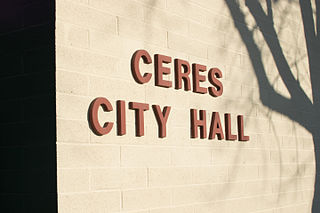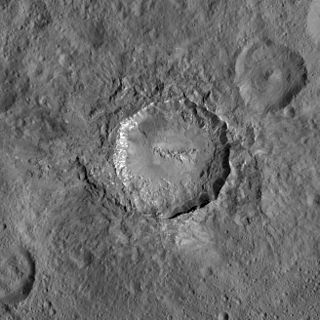
An asteroid is a minor planet—an object that is neither a true planet nor a comet—that orbits within the inner Solar System. They are rocky, metallic, or icy bodies with no atmosphere. The size and shape of asteroids vary significantly, ranging from small rubble piles under a kilometer across to Ceres, a dwarf planet almost 1000 km in diameter.

Proserpina or Proserpine is an ancient Roman goddess whose iconography, functions and myths are virtually identical to those of Greek Persephone. Proserpina replaced or was combined with the ancient Roman fertility goddess Libera, whose principal cult was housed in the Aventine temple of the grain-goddess Ceres, along with the wine god Liber.

Ceres is a city in Stanislaus County, California. Its population was 49,302 at the 2020 U.S. Census, up from 45,417 at the 2010 U.S. Census. It is part of the Modesto metropolitan statistical area.

Dawn is a retired space probe that was launched by NASA in September 2007 with the mission of studying two of the three known protoplanets of the asteroid belt: Vesta and Ceres. In the fulfillment of that mission—the ninth in NASA's Discovery Program—Dawn entered orbit around Vesta on July 16, 2011, and completed a 14-month survey mission before leaving for Ceres in late 2012. It entered orbit around Ceres on March 6, 2015. In 2017, NASA announced that the planned nine-year mission would be extended until the probe's hydrazine fuel supply was depleted. On November 1, 2018, NASA announced that Dawn had depleted its hydrazine, and the mission was ended. The derelict probe remains in a stable orbit around Ceres.

A cryovolcano is a type of volcano that erupts volatiles such as water, ammonia or methane into an extremely cold environment that is at or below their freezing point. The process of formation is known as cryovolcanism. Collectively called cryomagma, cryolava or ice-volcanic melt, these substances are usually liquids and can form plumes, but can also be in vapour form. After the eruption, cryomagma is expected to condense to a solid form when exposed to very low surrounding temperatures. Cryovolcanoes may potentially form on icy moons and other objects with abundant water past the Solar System's snow line. A number of features have been identified as possible cryovolcanoes on Pluto, Titan and Ceres, and a subset of domes on Europa may have cryovolcanic origins.

Aarhus Stadium is an association football stadium in Aarhus, Denmark which has been the home ground of Aarhus Gymnastikforening since the 1920s. With a current capacity of 19,433, it is the third largest football stadium of any football team in Denmark. It is part of the sports complex, known as Aarhus Sports Park, that is run by Ceres Park & Arena.

Ceres is a dwarf planet in the middle main asteroid belt between the orbits of Mars and Jupiter. It was the first asteroid discovered on 1 January 1801, by Giuseppe Piazzi at Palermo Astronomical Observatory in Sicily and announced as a new planet. Ceres was later classified as an asteroid and then a dwarf planet, the only one always inside Neptune's orbit.

Risto Vidaković is a Serbian professional football manager and former player and current head coach of Liga 1 club PSS Sleman.

Global Football Club was a professional football club that last played in the Philippines Football League (PFL), the top flight of Philippines' club football. The club has won four league titles, two UFL Cups, one UFL FA Cup, and one PFF National Men's Club Championship. They have participated in the AFC Cup three times.

United City Football Club is a Filipino professional football club based in New Clark City in Capas, Tarlac, that last competed in Philippines Football League (PFL), the top-tier league of football in the Philippines. From 2012 to 2020, the club was known as Ceres and was associated with Ceres Liner, a bus company owned by Leo Rey Yanson, the club owner and chairman during that period. As Ceres, its home venue was Panaad Stadium in Bacolod, Negros Occidental.

Occator is an impact crater located on Ceres, the largest object in the main asteroid belt that lies between the orbits of Mars and Jupiter, that contains "Spot 5", the brightest of the bright spots observed by the Dawn spacecraft. It was known as "Region A" in ground-based images taken by the W. M. Keck Observatory on Mauna Kea.

Haulani is an impact crater located on Ceres that contains "Spot 1", one of the bright spots observed by the Dawn spacecraft. The crater was named after Haulani, the Hawaiian goddess of plants. In July 2018, NASA released a comparison of physical features, including Haulani crater, found on Ceres with similar ones present on Earth.

The geology of Ceres consists of the characteristics of the surface, the crust and the interior of the dwarf planet Ceres. The surface of Ceres is comparable to the surfaces of Saturn's moons Rhea and Tethys, and Uranus's moons Umbriel and Oberon.

Achita is a large crater on Ceres.

Sound of Ceres is an American dream pop collaboration with K and Ryan Hover of Candy Claws at the band's core. After releasing three albums under the moniker Candy Claws, K and Ryan Hover decided to develop a new sound with a new band, founding Sound of Ceres in Fort Collins, Colorado in 2014. Other members include Jacob Graham and Derrick Bozich.
The 2018 season is Home United's 23rd consecutive season in the top flight of Singapore football and in the S.League. Along with the S.League, the club will also compete in the Prime League, the Singapore Cup, Singapore League Cup.

Galactic Energy is a Chinese private space launch enterprise flying the Ceres-1 and developing the Pallas-1 and 2 orbital rockets. The company's long-term objective is to mine asteroids for rare metals and minerals.

Oxo is a small impact crater on the dwarf planet Ceres, located in Ceres' northern hemisphere. It is the second-brightest feature on Ceres. The crater was named after the Candomblé god of agriculture.

















